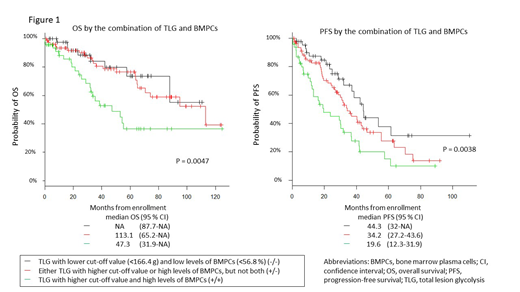Introduction: Multiple myeloma (MM) is a heterogeneous malignant plasma cell (PC) disorder and the survival ranges from several months to > 10-years. Several risk stratification systems such as the Revised International Staging System (R-ISS) have been developed. PET/CT allows the direct assessment of metabolic tumor burden in various malignancies. Therefore, metabolic tumor volume (MTV) and total lesion glycolysis (TLG), which are volumetric parameters applicable to PET/CT, are emerging tools for MM prognostication. This study was aimed to determine the value of MTV and TLG using PET/CT in the prognostication and in combination with various hematologic parameters such as bone marrow PC (BMPC) percentages and circulating tumorous PCs (CPCs) to identify the patients with high-risk features.
Methods: A total of 196 consecutive patients with newly diagnosed MM (NDMM) who underwent baseline whole-body PET/CT between January 2009 and June 2019 at Kameda Medical Center, Kamogawa-shi, Japan, were retrospectively analyzed. PET/CT was performed using dedicated PET/CT scanners (Discovery ST Elite Performance; GE Healthcare, Milwaukee, USA). The standard uptake value (SUV) was normalized according to the injected dose and lean body mass. The baseline SUVmax of all lesions was recorded, and the highest value was considered as the SUVmax of the patient. MTV was defined as the myeloma lesions volume visualized on PET/CT scans with SUV greater than or equal to the fixed absolute threshold of SUV = 2.5. TLG was calculated as the sum of the product of average SUV (SUVmean) and MTV of all lesions. Computer‐aided analysis of PET-CT images for MTV and TLG calculations was performed using an open-source software application of Metavol (Hokkaido University, Sapporo, Japan). The CPCs were measured using an 8-color flowcytometry and reported as the percentage per total mononuclear cells using the monoclonal antibodies of CD19, 38, 45, 56, 117, 200, κ, λ, and CD138. The BMPC was calculated by counting the percentages of CD138-stained PCs among the all nucleated cells on bone marrow biopsy samples. Eleven patients (13.8%) were excluded because the MTV data could not be retrieved. Ultimately, 185 patients were included in our analysis. Written informed consent was obtained from all patients.
Results: Among the 185 patients, 28 patients (15.1%) were negative for avid lesion on PET/CT. Whole-body MTV and TLG ranged from 0 to 2440.7 mL, with a median of 34.2 mL and from 0 to 12582.4 g, with a median of 97.0 g, respectively. The best cut-off values of MTV and TLG that discriminate the survival using a receiver-operating-characteristic curve analysis were 56.4 mL and 166.4 g, respectively. The overall survival (OS) and progression-free survival (PFS) of patients with a lower cut-off value of MTV (≤56.4 mL) had better survival with not reached (NR) and 37.3 months as compared to those with a higher cut-off value (>56.4 mL) that reached 52.9 and 23.8 months, respectively (p=0.003 and 0.019). Similarly, the OS and PFS of patients with a lower cut-off value of TLG (≤166.4 g) showed better survivals with NR and 37.3 months as compared to those with a higher cut-off value (>166.4 g) that reached 54.3 and 28.8 months, respectively (p=0.0047 and 0.012).
Next, we explored the prognostic impact of the clinical variables including MTV or TLG, CPCs, and BMPC. High levels of CPCs and BMPCs levels were defined as ≥0.018% of the total mononuclear cells and BMPCs of ≥57%, respectively. Univariate analysis showed that age≥70, serum creatinine≥2.0 mg/dL, R-ISS stage 3, higher cut-off value of MTV, and higher cut-off value of TLG were the associated with shorter OS. To measure the tumor volume with accuracy, we combined BMPC or CPCs and MTV or TLG. On multivariate analysis, age≥70 and the combination of higher cut-off value of MTV or TLG and high level of BMPC percentage were significantly associated with shorter OS [Hazard Ratio (HR) 2.12, p=0.038, HR 2.66, p=0.027 and HR 2.57, p=0.029, respectively] and PFS (Not assessed, HR 2.52, p=0.018 and HR 2.7, p= 0.011, respectively) (Figure 1).
Conclusion: Our findings demonstrated that MTV and TLG calculated from pretreatment PET/CT were useful for risk stratification in patients with NDMM when combined with BMPC. The prognostic performance of the combined high-burden of TLG or MTV and high levels of BMPC were independent of the established risk factors.
Matsue:Novartis Pharma K.K: Honoraria; Janssen Pharmaceutical K.K.: Honoraria; Celgene: Honoraria; Takeda Pharmaceutical Company Limited: Honoraria; Ono Pharmaceutical: Honoraria.
Author notes
Asterisk with author names denotes non-ASH members.


This feature is available to Subscribers Only
Sign In or Create an Account Close Modal